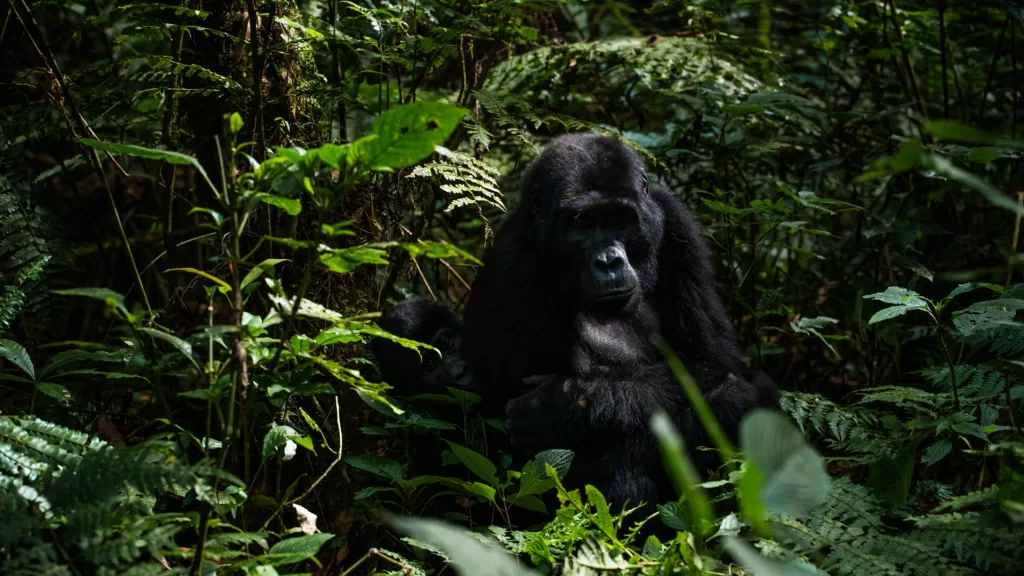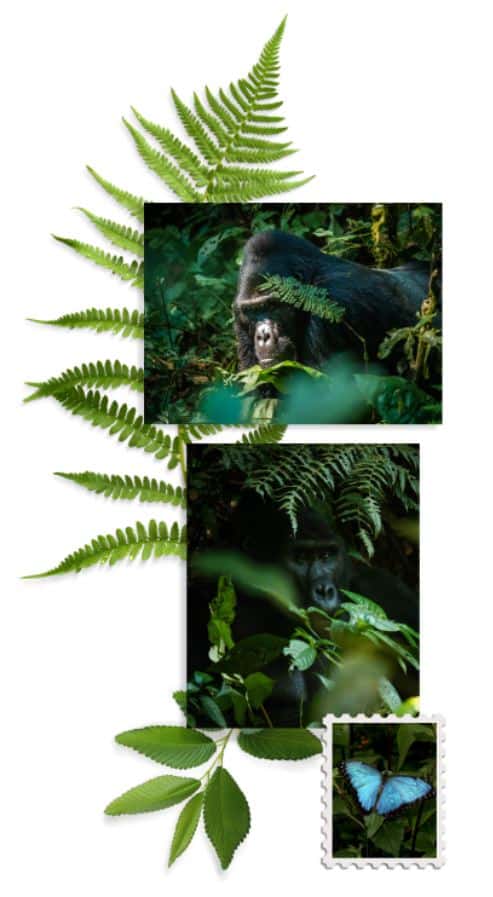Bwindi Impenetrable Forest
Where Mountain Gorillas Tread
Up ahead, a L’Hoest’s monkey, distinctive for the snow-white ruff that frames a black face and deep-set orange eyes, is crossing the leaf-littered trail, first looking right then left, like a well-drilled school kid, before scampering off to catch up with the troop that is foraging on the forest floor for fallen fruit, mushrooms, and the choicest of sweet flowers. Not for the first time, I pat myself on the back for having decided to take a short-cut by walking, instead of driving, to the small dusty village of Buhoma in south-west Uganda, the jumping-off point for Uganda’s prime gorilla tracking experiences (a staggering 459, or 45% of the world’s mountain gorilla population, dwell within this forest at Bwindi).
It wasn’t a decision made lightly. The trek is through the imagination-stirring UNESCO World Heritage Site of Bwindi Impenetrable Forest, a rugged 331 km sq. national park of steep hills and deep valleys that roll from the Albertine Rift Escarpment. Tourists are warned not to go it alone armed with nothing but binoculars and a positive attitude, as you are barely ten kilometers from the border of the Democratic Republic of the Congo, with its ongoing civil unrest. Although it’s extremely unlikely that you’ll run into trouble, Uganda tourism authorities won’t take any chances. And the acquisition of an armed guard (as in gun-carrying) to escort you is advised. It is also handy for scare-shooting away any errant bull elephant.
My fertile imagination is soon brought into check by a national park ranger, who has much smaller concerns than insurgents and charging pachyderms. “Are you wearing insect repellent?” he wants to know as soon as we scramble from the jeep, relieved that our journey on unpaved roads, which has tossed us around like peas in a can, is now over. I am, but to be on the safe side, I immediately begin to search in my daypack for more to douse on. “Better not to,” comes the quick advice. “The wasps love it.” As if to prove a point, I hear a yelp from Freddie, my seventeen-year-old son, who has been stung on the neck.
The small dusty village of Buhoma in south-west Uganda is the jumping-off point for Uganda’s prime gorilla tracking experiences

The instruction is to keep moving, which we do, following a squad of muscly porters hired to carry our luggage. (Not only is this practical, but tourists are encouraged to employ porters’ services as it supplies a steady income to rural communities). It’s thrilling to strike out from the rim of the forest, bordered by lush green tea plantations that look sketched by fluorescent pen, and it’s only a matter of twenty minutes before we’re engulfed in thick vegetation.
Our route along an old logging road cuts a swath through glades of giant ferns and feels like a fitting warm-up for the pilgrimage we’ll embark on tomorrow to meet mountain gorillas. For now, though, it’s other primates that catch our eye. Red-tailed monkeys swing high from African brown mahogany trees. And the reminder that we make an unusual band of travelers comes from the obvious curiosity of Black and white colobus monkeys that peek between the leaves shyly to watch our progression. And although we don’t see olive baboon, we hear them whooping it up within woods, their calls like breathy laughter. Cream-banded swallowtail and iridescent blue nymphalid butterflies (just two in over 200 species found here) flit over the small burbling streams fed by hidden waterfalls, which we cross by hopping from moss-covered stone to boulder.
Of my travels through Uganda, Buhoma is my favorite destination. The extra effort required to get there gives the small town a pleasingly final frontier vibe. And from Volcanoes Safaris’ lovely Bwindi Lodge, the views are only to the forest, from which the buzz and click of insects and chirp of abundant bird life never cease. Plus, my room comes with a free pet: a chameleon, discovered mid-transformation from purplish red to mottled brown. We spend our first evening hanging out on Buhoma’s one-strip “high street” drinking Tusker beer on the terrace of the lodge’s Bwindi Bar, where hospitality training is offered to local disadvantaged youngsters. Apart from a lively debate between three women over the value of a plump chicken, and a game of impromptu football, the scene is pleasingly quiet.

Next day, we’re up to watch the night turn from pitch black to violet, and the sunbirds stir. By the time we reach the tiny, picturesque village of Ruhija, hugged by tea plantations planted on steep terraces, the atmosphere is of a milky apricot hue. We’re not the only early risers. A line of gum-booted porters waits, hoping to score a job for the day. Today we’re only lugging small backpacks containing rain gear, water, and packed lunches, but we don’t disappoint. This is arguably the most scenic spot from which to set off mountain gorilla tracking. And we descend through tea plantations hung in gauze-like mists to the valley floor and the boundary of the national park. From here, the only way is up, along the narrowest dirt tracks through the primeval forest.
As my knees crunch, I quickly learn that porters aren’t just there to carry your packed lunch but also to give you a pull or push up should you flounder. The trail is barely visible at times, and ahead of us, the guard sweeps away nettles, vines, and brambles using a large machete. When a call comes from a tracker deep within the forest, we all stand stock still and look to Wilbur, the ranger. “We’re not far from the gorillas now,” he says. “Leave your belongings with the porters and drink an hour’s worth of water before we set off.”

Through dense thorny brambles, the tracker’s machetes swing until we reach a clearing where three females are feeding on stems and leaves. The matriarch of the ten-strong Orozugo gorilla family rises and makes a beeline for me, and I’m little prepared for the intensity of her gaze, one mother to another, or how deeply I feel our connection (and why wouldn’t I, when we share 98% of the same DNA?).
Then, like mothers are, we’re both distracted by the arrival of her one-year-old son, who, after attempting a clumsy beat of his chest, climbs onto her back to peer over her head at us all. “He’s showing off,” Wilbur tells us. “He’s saying, look at me! See how strong I am!” We’re all so mesmerized by the youngster’s antics that we don’t notice that Bakwate, the silverback, has stirred, arriving to us with a heart-stopping gallop, the glossy saddle of silver on his back bristling and every inch of his 198-kilo muscled body rippling. We offer a hasty “mm mer” (gorilla speak for “we’re no threat”) and crouch down until he loses interest and rolls onto his back for a snooze. The tension is electric.

Bakwate, the silverback gorilla, arrives with a heart-stopping gallop, his glossy back bristling and every inch of his 198-kilo muscled body rippling
Engulfed by trees that drip with Spanish moss, we spend one privileged hour with our primate cousins, observing their play, social interaction, and feeding habits, so like our own, and when one over-enthusiastic juvenile comes tumbling towards me during a play fight, I feel the joyful soft brush of warm gorilla hair against my leg.
“How was your experience?” Wilbur is keen to know as we begin the descent. All I can manage as a reply is a nod and a grin. Bwindi Impenetrable Forest and its mountain gorillas have quite literally stolen my breath away.
A version of this article appears in print, in Issue 2 of Álula Magazine, with the headline: “Bwindi Impenetrable Forest: Where Mountain Gorillas Tread .”


